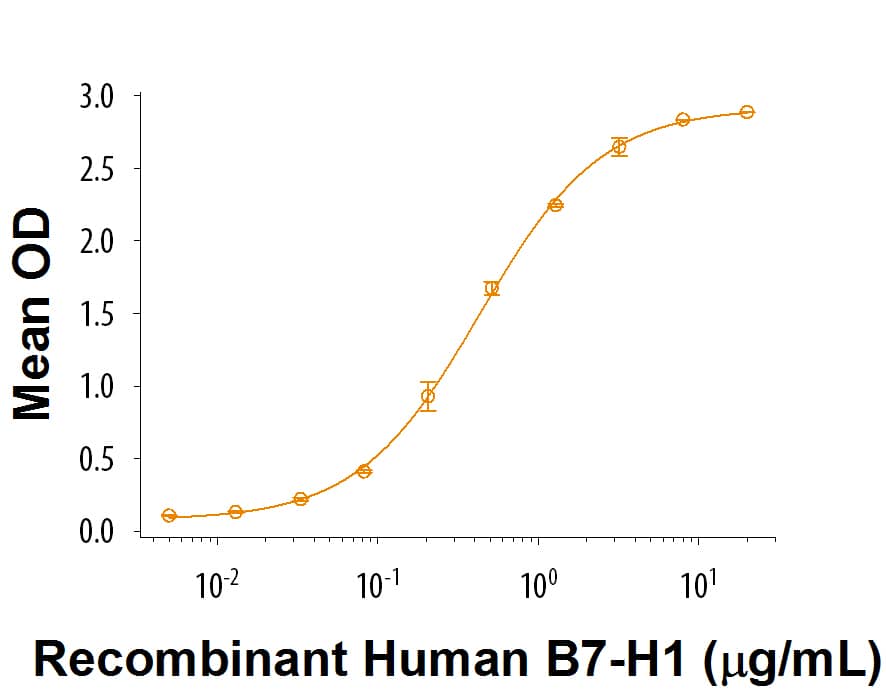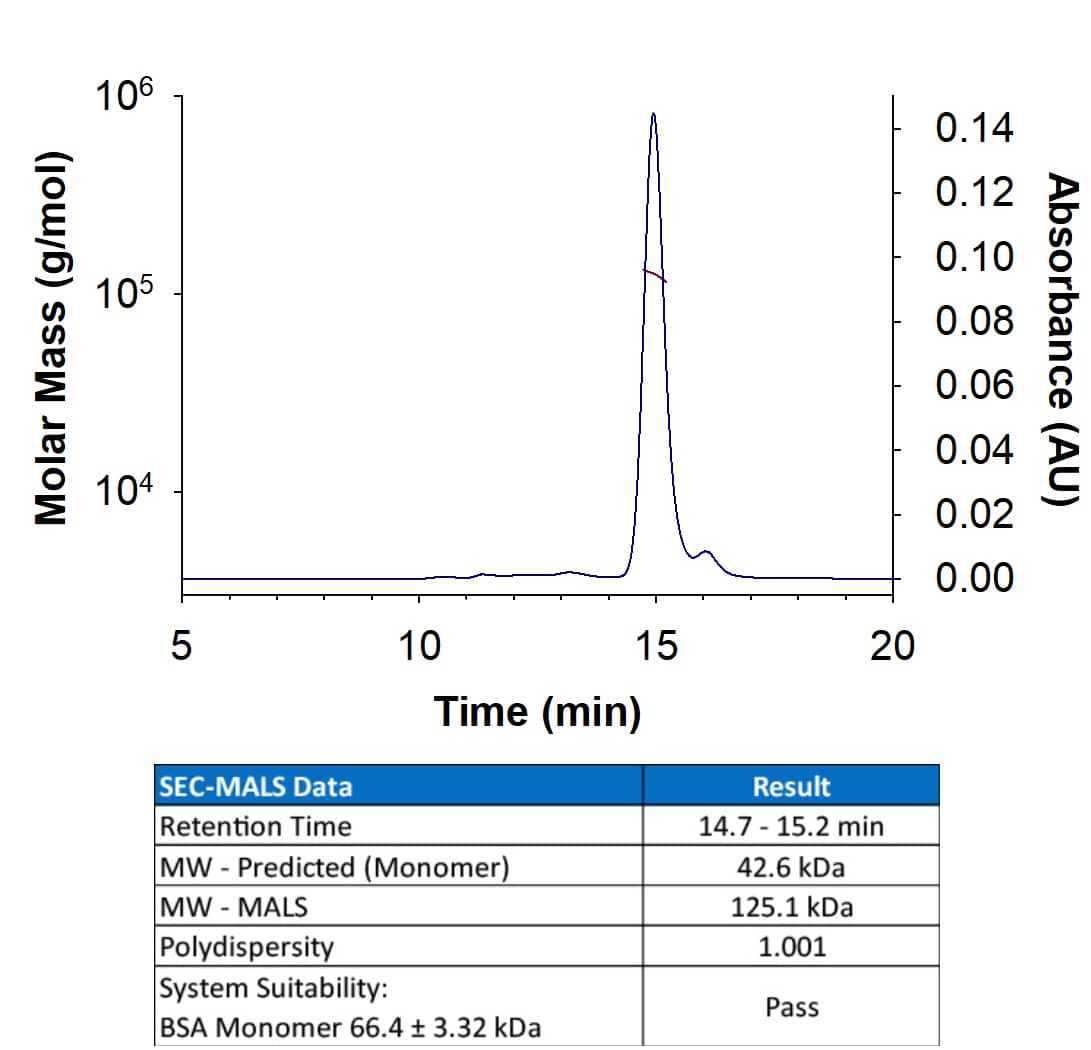Recombinant Human PD-1 Fc Chimera Protein, CF Best Seller
R&D Systems, part of Bio-Techne | Catalog # 1086-PD

Key Product Details
Source
Accession #
Structure / Form
Conjugate
Applications
Product Specifications
Source
| Human PD-1 (Leu25-Gln167) Accession # Q15116.3 |
IEGRMD | Human IgG1 (Pro100-Lys330) |
| N-terminus | C-terminus |
Purity
Endotoxin Level
N-terminal Sequence Analysis
Predicted Molecular Mass
SDS-PAGE
Activity
When Recombinant Human PD-1 Fc Chimera is immobilized at 0.1 µg/mL (100 µL/well), Recombinant Human B7-H1/PD-L1 Fc Chimera (Catalog # 156-B7) binds with a typical ED50 of 0.15-0.75 μg/mL.
Reviewed Applications
Read 10 reviews rated 4.7 using 1086-PD in the following applications:
Scientific Data Images for Recombinant Human PD-1 Fc Chimera Protein, CF
Recombinant Human PD‑1 Fc Chimera Protein SEC-MALS.
Recombinant human PD-1/Fc (Catalog # 1086-PD) has a molecular weight (MW) of 125.1 kDa as analyzed by SEC-MALS, suggesting that this protein is a homodimer. MW may differ from predicted MW due to post-translational modifications (PTMs) present (i.e. Glycosylation).Bioactivity of Human PD-1 Protein
When Recombinant Human PD-1 Fc Chimera (Catalog # 1086-PD) is coated at 0.1 µg/mL, Recombinant Human B7-H1/PD-L1 Fc Chimera (156-B7) binds with a typical ED50 of 0.15-0.75 µg/mL.Formulation, Preparation and Storage
1086-PD
| Formulation | Lyophilized from a 0.2 μm filtered solution in PBS. |
| Reconstitution |
Reconstitute at 0.5 mg/mL in sterile PBS.
|
| Shipping | The product is shipped at ambient temperature. Upon receipt, store it immediately at the temperature recommended below. |
| Stability & Storage | Use a manual defrost freezer and avoid repeated freeze-thaw cycles.
|
Background: PD-1
PD-1 protein is type I transmembrane receptor belonging to the CD28 family of immune regulatory receptors (1). Other members of this family include CD28, CTLA-4, ICOS, and BTLA (2-5). Mature human PD-1 consists of an extracellular region (ECD) with one immunoglobulin-like V‑type domain, a transmembrane domain, and a cytoplasmic region. The mature ECD of human PD-1 shares 61% amino acid sequence identity with mouse PD-1 ECD. PD-1 protein acts as a monomeric receptor and interacts in a 1:1 stoichiometric ratio with its ligands PD-L1 (B7-H1) and PD-L2 (B7-DC) (6, 7). PD‑1 is expressed on activated T cells, B cells, monocytes, and dendritic cells while PD-L1 expression is constitutive on the same cells and also on nonhematopoietic cells such as lung endothelial cells and hepatocytes (8, 9). Ligation of PD-L1 with PD-1 induces co-inhibitory signals on T cells promoting their apoptosis, anergy, and functional exhaustion (10). Thus, the PD-1:PD-L1 interaction is a key regulator of the threshold of immune response and peripheral immune tolerance (11).
References
- Ishida, Y. et al. (1992) EMBO J. 11:3887.
- Sharpe, A.H. and G.J. Freeman (2002) Nat. Rev. Immunol. 2:116.
- Coyle, A. and J. Gutierrez-Ramos (2001) Nat. Immunol. 2:203.
- Nishimura, H. and T. Honjo (2001) Trends Immunol. 22:265.
- Watanabe, N. et al. (2003) Nat. Immunol. 4:670.
- Zhang, X. et al. (2004) Immunity 20:337.
- Lázár-Molnár, E. et al. (2008) Proc. Natl. Acad. Sci. USA 105:10483.
- Nishimura, H. et al. (1996) Int. Immunol. 8:773.
- Keir, M.E. et al. (2008) Annu. Rev. Immunol. 26:677.
- Butte, M.J. et al. (2007) Immunity 27:111.
- Okazaki, T. et al. (2013) Nat. Immunol. 14:1212.
- Iwai, Y. et al. (2002) Proc. Natl. Acad. Sci. USA 99:12293.
- Nogrady, B. (2014) Nature 513:S10.
Long Name
Alternate Names
Entrez Gene IDs
Gene Symbol
UniProt
Additional PD-1 Products
Product Documents for Recombinant Human PD-1 Fc Chimera Protein, CF
Product Specific Notices for Recombinant Human PD-1 Fc Chimera Protein, CF
For research use only

